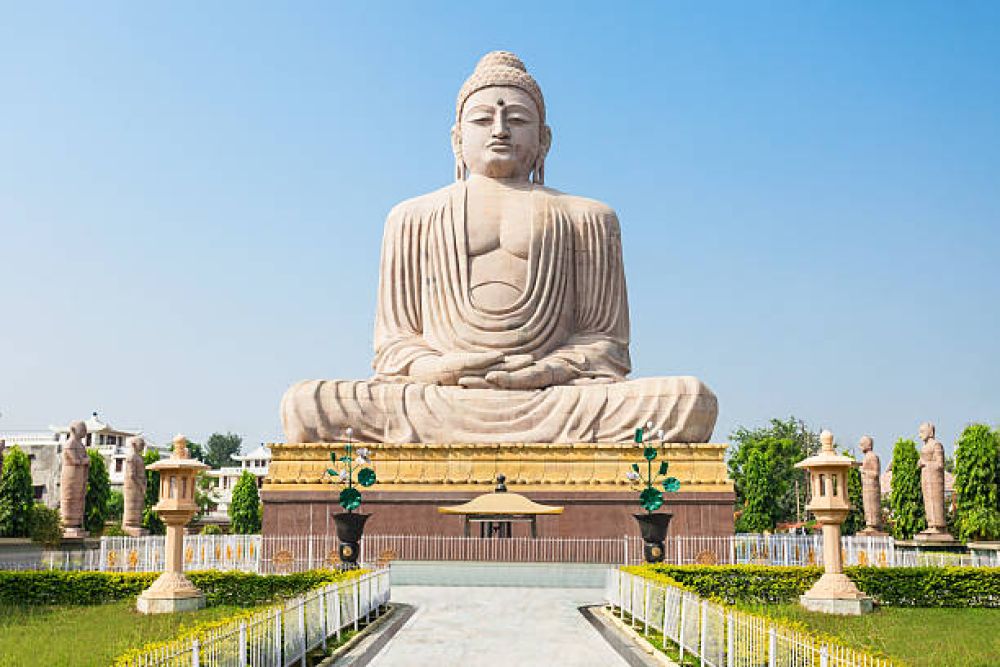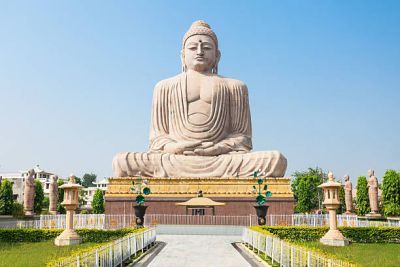

The Mahabodhi Temple is one of the most revered sites in Buddhism, marking the location where Siddhartha Gautama, the Buddha, attained enlightenment. This UNESCO World Heritage site is an architectural marvel with a stunning 50-meter-high pyramidal spire adorned with carvings and stucco work. The sprawling complex houses the descendant of the original Bodhi Tree under which the Buddha meditated. Visitors can explore the meditative gardens, prayer halls, and the serene Lotus Pond. The temple's ambiance is one of peace and spirituality, and it attracts pilgrims from around the world. Regardless of religious affiliation, visitors can appreciate the historical significance and cultural importance of this sacred site. Photography is allowed in some areas, but remember to be respectful of worshippers and the sanctity of the temple.
For a truly spiritual experience, visitors to Bodh Gaya can sit and meditate under the Bodhi Tree, believed to be a direct descendant of the original tree where Buddha found enlightenment over 2,500 years ago. The atmosphere around the tree is one of profound peace and serenity, conducive to meditation and reflection. Engaging in meditation here is not just a tourist activity but a passage to connect with oneself and the essence of Buddhism. Many visitors report a unique sense of calm and clarity during and after their meditation. This experience is suitable for experienced practitioners and novices alike, and it is a rare opportunity to follow in the footsteps of the Buddha in such a historically significant setting.
The Great Buddha Statue stands as a serene sentinel in Bodh Gaya, its imposing presence an iconic symbol of peace and compassion. Towering at 80 feet, the statue was inaugurated by the 14th Dalai Lama in 1989 and is one of the region's most visited attractions. It depicts Buddha in the earth-touching mudra, symbolizing the moment of his enlightenment. Visitors can walk around the statue, take in the detailed craftsmanship, and sit on the surrounding grounds for contemplation. The area is often bustling with monks and pilgrims reciting mantras and meditating, lending a powerful spiritual atmosphere to the site. The statue is especially beautiful at sunrise and sunset when the light casts a warm glow over the figure.
The Thai Monastery in Bodh Gaya is an exquisite example of traditional Thai architecture outside of Thailand. Gifted by the Thai government to India, it stands out with its golden roof and intricately carved designs. Visitors to the monastery will find a large bronze statue of Buddha and a beautifully manicured garden. The Thai Monastery also serves as a place of study and residence for Thai monks, and it is a center of cultural exchange between the two nations. The quietude and beauty of the surroundings provide a cultural as well as a spiritual insight into Thai Buddhist practices. Observing the daily rituals and interactions of the monks can be thought-provoking and offers a glimpse into the monastic lifestyle.
For those interested in culture and shopping, the Tibetan Refugee Market in Bodh Gaya is a must-visit. This bustling bazaar is filled with stalls selling traditional Tibetan handicrafts, woollen clothes, and exquisite jewelry. It's an excellent place to buy souvenirs such as thangkas (Tibetan religious paintings), prayer wheels, and Buddha statues. Beyond shopping, the market offers insight into the lives of Tibetan refugees who have made Bodh Gaya their home. Interacting with the stall owners, many of whom are refugees or descendants of refugees, provides a deeper understanding of their culture and history. Bargaining is common here, so visitors can practice their haggling skills and pick up some unique items at reasonable prices.
Dedicated to preserving the rich history and archaeological findings of the region, the Bodh Gaya Archaeological Museum features a collection of Buddhist sculptures and artifacts dating from the 1st century BC to the 11th century AD. Exhibits include stone sculptures of Hindu deities, Buddha figures in various postures, and relics from nearby excavation sites. The museum's centerpiece is the beautifully carved railing from the original Mahabodhi Temple. A visit to this museum provides context to Bodh Gaya’s historical significance and offers an informative respite from the religious and spiritual activities in the area. The well-kept grounds and orderly presentation of artifacts make it a pleasant and educational experience for history lovers and casual tourists alike.
A little piece of history can be unearthed at Sujata Garh, an ancient stupa found in the village of Bakraur. It commemorates the spot where Sujata, a local village girl, is believed to have offered milk rice to the emaciated Siddhartha, helping him regain strength and resolve just before his ultimate enlightenment. Visitors can explore the ruins and envisage the vivid historical account that took place at this very location. Surrounded by agricultural fields and simple village life, Sujata Garh provides a contrasting experience to the busier temple sites. It's a peaceful area for reflection on the Buddha's journey and for considering the contributions of unsung figures in history who have played significant roles in shaping spiritual narratives.
The Royal Bhutan Monastery is another striking example of the cultural diversity within Bodh Gaya. This monastery is adorned with intricate carvings that depict various scenes from Buddha's life, providing both a visual feast and an educational experience. Visitors here can admire the craftsmanship, and the serene environment is conducive to contemplation. The monastery is also actively involved in Buddhist teachings and the promotion of the values of peace and harmony. A visit here not only is an opportunity to appreciate Bhutanese architecture and art but also to learn about the ways Buddhist philosophy can be applied to everyday life. It's a tranquil space within the busy town and provides a nice spot for those seeking a quiet place to think or meditate.
Located about 12 kilometers from Bodh Gaya, the Dungeshwari Hills are home to the Mahakala Caves. These caves hold historical significance as the place where the Buddha is believed to have practiced severe asceticism before deciding on the Middle Way to enlightenment. Visitors can explore the caverns with their temples and shrines and see the depictions of Buddha's life as an ascetic. The hilltop location offers panoramic views of the surrounding landscape, and the path to the caves is a journey through nature's serenity. Though the climb may be steep, the spiritual and historical ambiance of the caves provides a unique insight into an important phase of the Buddha's spiritual journey.
The Niranjana River, also known as the Lilajan or Phalgu, flows nearby Bodh Gaya and is associated with significant events in the Buddha's life, including his crossing after leaving the palace. While the river is not as mighty as others in India, it still holds spiritual significance. Visitors to the Niranjana River can take a quiet stroll along its banks or simply spend some time reflecting. The river is often a site of religious ceremonies and rituals, allowing visitors to witness local customs and traditions. Although it is more subdued than other attractions in Bodh Gaya, the river offers a glimpse into the natural environment that has shaped the spiritual history of the region.
